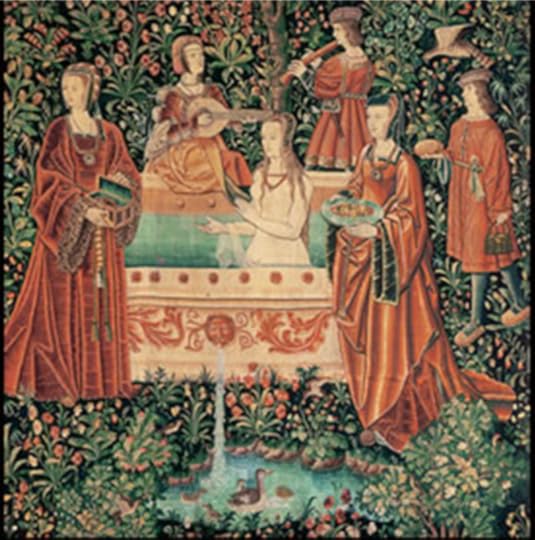Jonathan Posner's Blog, page 11
June 22, 2022
The Sovereign’s Secret – launches 5th August

I am pleased to announce that The Sovereign’s Secret, the third book in The Witchfinder’s Well trilogy, is now available to pre-order on Amazon – ahead of the launch on 5th August 2022.
Reserve your copy now to get your download on launch day!
June 8, 2022
Be the first to read and comment on The Sovereign’s Secret!

The curent draft of The Sovereign’s Secret is immediately available for a limited time for beta readers – advanced copy readers who are invited to read and comment on the book prior to publication.
Please click on the image below in order to downoad the book in PDF form. Once you have reached the end of the book, please come back to this page and complete the short questionnaire below, so I get your feedback.
Timing: I need feedback by the end of June in order to hit dates agreed with my editor and with Amazon for publication.
Thanks in advance!
Please enable JavaScript in your browser to complete this form.Name *FirstLastEmailPlease enter your email, if it's OK for me to follow up with any questions or clarifications on your answers below. Thanks.Overall, how well do you think The Sovereign's Secret concludes the trilogy? Mark it out of 10, where 1 = very poorly, to 10 = excellently Selected Value: 0Please slide the dot to your desired numberIn overview, what did you like best about the book?In overview, what would you most like to change about it?In more detail, did you think the plot worked? If yes, what worked best for you? If no, why not?In more detail, did you think the characters worked? Which character was most credible? Which was the least? Why?Any final comments?And lastly, would you recommend this book to your friends?YesNoNot sureThanks for your input - it is greatly appreciated. As a 'thank you' your name will be included in the 'Acknowledgements' at the front of the book when it is published, and I will send you a free signed paperback copy. Please confirm if you are happy for me to do this, and if 'yes', please give a postal address to send the signed copy.YesNoAddressAddress Line 1Address Line 2CityState / Province / RegionPostal CodeAfghanistanÅland IslandsAlbaniaAlgeriaAmerican SamoaAndorraAngolaAnguillaAntarcticaAntigua and BarbudaArgentinaArmeniaArubaAustraliaAustriaAzerbaijanBahamasBahrainBangladeshBarbadosBelarusBelgiumBelizeBeninBermudaBhutanBolivia (Plurinational State of)Bosnia and HerzegovinaBotswanaBouvet IslandBrazilBritish Indian Ocean TerritoryBrunei DarussalamBulgariaBurkina FasoBurundiCabo VerdeCambodiaCameroonCanadaCayman IslandsCentral African RepublicChadChileChinaChristmas IslandCocos (Keeling) IslandsColombiaComorosCongoCongo (Democratic Republic of the)Cook IslandsCosta RicaCôte d'IvoireCroatiaCubaCuraçaoCyprusCzech RepublicDenmarkDjiboutiDominicaDominican RepublicEcuadorEgyptEl SalvadorEquatorial GuineaEritreaEstoniaEthiopiaFalkland Islands (Malvinas)Faroe IslandsFijiFinlandFranceFrench GuianaFrench PolynesiaFrench Southern TerritoriesGabonGambiaGeorgiaGermanyGhanaGibraltarGreeceGreenlandGrenadaGuadeloupeGuamGuatemalaGuernseyGuineaGuinea-BissauGuyanaHaitiHeard Island and McDonald IslandsHondurasHong KongHungaryIcelandIndiaIndonesiaIran (Islamic Republic of)IraqIreland (Republic of)Isle of ManIsraelItalyJamaicaJapanJerseyJordanKazakhstanKenyaKiribatiKorea (Democratic People's Republic of)Korea (Republic of)KuwaitKyrgyzstanLao People's Democratic RepublicLatviaLebanonLesothoLiberiaLibyaLiechtensteinLithuaniaLuxembourgMacaoNorth Macedonia (Republic of)MadagascarMalawiMalaysiaMaldivesMaliMaltaMarshall IslandsMartiniqueMauritaniaMauritiusMayotteMexicoMicronesia (Federated States of)Moldova (Republic of)MonacoMongoliaMontenegroMontserratMoroccoMozambiqueMyanmarNamibiaNauruNepalNetherlandsNew CaledoniaNew ZealandNicaraguaNigerNigeriaNiueNorfolk IslandNorthern Mariana IslandsNorwayOmanPakistanPalauPalestine (State of)PanamaPapua New GuineaParaguayPeruPhilippinesPitcairnPolandPortugalPuerto RicoQatarRéunionRomaniaRussian FederationRwandaSaint BarthélemySaint Helena, Ascension and Tristan da CunhaSaint Kitts and NevisSaint LuciaSaint Martin (French part)Saint Pierre and MiquelonSaint Vincent and the GrenadinesSamoaSan MarinoSao Tome and PrincipeSaudi ArabiaSenegalSerbiaSeychellesSierra LeoneSingaporeSint Maarten (Dutch part)SlovakiaSloveniaSolomon IslandsSomaliaSouth AfricaSouth Georgia and the South Sandwich IslandsSouth SudanSpainSri LankaSudanSurinameSvalbard and Jan MayenSwazilandSwedenSwitzerlandSyrian Arab RepublicTaiwan, Province of ChinaTajikistanTanzania (United Republic of)ThailandTimor-LesteTogoTokelauTongaTrinidad and TobagoTunisiaTurkeyTurkmenistanTurks and Caicos IslandsTuvaluUgandaUkraineUnited Arab EmiratesUnited Kingdom of Great Britain and Northern IrelandUnited States of AmericaUnited States Minor Outlying IslandsUruguayUzbekistanVanuatuVatican City StateVenezuela (Bolivarian Republic of)Viet NamVirgin Islands (British)Virgin Islands (U.S.)Wallis and FutunaWestern SaharaYemenZambiaZimbabweCountryYour address will only be used to send the free copy and will not be retained or used for any other purpose.Are you OK for me to use any of your comments and your name as quotes in my marketing for the book? Many thanks.Yes - name and commentsYes, but comments onlyNoEmailSubmit
April 27, 2022
The Sovereign’s Secret – here soon!

The first draft of The Sovereign’s Secret has been completed, and Jonathan is now working through the second draft. The story is coming together nicely and he plans to put it out to beta readers in early Summer 2022, with a view to having it edited and published in August.
Once again Lady Mary is plunged into mortal danger, this time on the orders of the calculating spy master Francis Walsingham.
Only it’s the last part of the trilogy, so anything can happen!
But one thing is for certain…
…this time history is definitely going to change!
Use the Contact page to get in touch if you would like to be one of the Beta Readers and get a first look at Lady Mary’s third exciting adventure.
New cover reveal

With the launch of The Sovereign’s Secret in August 2022, the covers of the two previous books in the trilogy have been updated so all three covers now work together more clearly.

The new covers are now live on Amazon, so check them out!
The Zombie Invasion

It was ever thus – the older generation complaining about the behaviour of the young.
Certainly my parents did so as I was growing up in the 1970s and 80s, and I now find myself doing exactly the same.
(I do accept that with the dreadful things going on in the world right now, my complaint does rather pale into insignificance. But anyway, here goes…)
What is it, I want to know, that is so overwhelmingly, so all-consumingly, so mind-blowingly important that people think it is perfectly OK to walk along the street not looking where they are going, but instead staring down at their phone with total absorption?
I believe they are called ‘Phone Zombies’ and I reckon in my daily walks through my home city centre I encounter at least ten or twelve of them; people (usually under 30 but sometimes older), walking confidently along the pavement through heavy foot traffic, their noses buried deep in their screens, completely, totally and utterly oblivious to those around them.
Is it an indication of the self-centric nature of our society, that as they are not looking where they are going, so it is the oncoming pedestrian’s responsibility to get out of their way?
I certainly have to dodge a fair few of these zombies every day, and each one adds another brick to the growing wall of frustration and annoyance that I have built up on this topic (does it show…?).
Perhaps I can put in a brief point of smug self-justification here… If I think of something I need to check on my phone while I am out walking, or it pings with a message, then do you know what I do? I pull over to the side of the pavement and I stop. Then, when I have finished looking at my phone, I put it away and resume my walk. I realise I am out of step with modern society, where the latest Instagram post or WhatsApp text is clearly more important than consideration for other pavement users, but hey, just call me old-fashioned…
However, back to these ‘Phone Zombies’. As each one goes past, I turn my head and give them what I believe Paddington Bear called a ‘hard stare’. This is of course, completely wasted and they continue to make their way along the street, scattering responsible citizens like an ice-breaker ploughing through an Antarctic sea. The only benefit is that it makes me feel as if I have responded in some way.
Another factor is that I am a very fast walker, and I find slow movers who hold me up highly frustrating. So anyone ambling in front of me with their attention firmly fixed on their phone is going to feel the full force of my passive-aggression as I stride past, glancing angrily at their screen to see just what could possibly be so vital that it is worth making me ‘step on the brakes’ and ‘shift down a gear or two’ as I walk.
If I approach from the front I watch to see if they do that little ‘eye flick’ upwards, which I assume would enable them to see where they are going. But mostly they seem to be navigating by what I can only assume is a superpower-level of peripheral vision. Unless, of course, there’s an app I haven’t yet come across, which makes use of a special camera built into the top of the latest phones that points forward at an angle (mine is a seven year-old model, so doesn’t qualify). Maybe the camera sends a little ‘picture in picture’ to the screen, showing the pavement ahead. Very useful if you want to keep up with important texts about tonight’s pub crawl, without needing to break your stride.
The Government has understandably taken a very dim view of people looking at their phones when driving, as the consequences of a moment’s inattention can be catastrophic for both the individual driver and for other road users. While I accept that distracted walking is clearly a lesser risk, my concern is that it will only take one zombie to step out into the path of an oncoming car, or one to collide with a pedestrian with a weak heart, to make ‘walking without due care and attention’ into something that should be actively policed.
Meanwhile, I continue to stride and dodge and stare ineffectively as I go about my daily walks through the crowded city centre pavements, hoping that maybe one day I will get to see a Phone Zombie bounce off a lamp-post, or do a comedy pratfall over a street bench, thus validating my view that society is falling apart and things ain’t what they used to be….
 If you want to see more ‘5 Minute Break’ articles, head over to my Substack page.
If you want to see more ‘5 Minute Break’ articles, head over to my Substack page.
April 26, 2022
Introducing Winter & Drew
All Jonathan’s books are now published under the Winter & Drew Publishing imprint. Find out more about Winter & Drew by clicking or tapping on the image.
December 8, 2020
A new Tudor heroine!

Mary Fox has arrived!
I am pleased to announce that my new novel has been been published on Amazon.
Mary Fox and the Broken Sword introduces a new heroine to Tudor England – at a time where young girls are expected to marry the man their father decides…
Mary Fox is a rebellious teenager who needs to escape from the evil Sir Reginald de Courtney, the older man her stepfather says she must marry.
From desperate swordfights to daring escapes, Mary battles to keep one step ahead of Sir Reginald. Will he catch her? And will he stop her in her quest to return the mysterious Broken Sword to its rightful home – and so lift a centuries-old curse?
For readers from 12 to adult, Mary Fox is a new heroine for any age!
Buy now on Amazon UK
Buy now on Amazon US
November 9, 2020
How Did the Tudors Stay Clean?
Guest Post
by
Bethshistoricalblog
In a year of viruses and disease, personal hygiene has never seemed so important. Handwashing, bathing and teeth-brushing seems second-nature to us in this modern society, and we all understand the importance of soap. Walk down the hygiene aisle at your local supermarket and you’ll see a torrent of fragranced, antibacterial soaps, gels, pastes, and creams. But for the Tudors, nipping down to their local store just wasn’t possible. So, how did they stay clean?
Contrary to popular belief, the Tudors were a lot more hygienic than we give them credit for. Soap would have been used in every household, regardless of status or wealth. For the upper classes, soaps made from natural oils or vegetable fats would be used to cleanse the skin, and more often than not they would have been fragranced with sweet smells such as lavender or sage. The poor would have had to make do with soaps made from cruder materials, such as animal fats, but it still got the job done.

Soaps consisting of these types of fats were also often used within the household, as a form of Tudor laundry detergent or washing-up liquid.
As well as sweet-smelling soaps, fragranced water would have been regularly used by the upper-class Tudors to rinse their hands, especially before they dined. The Tudors did not use cutlery as we would today, and instead they (even the royals!) often ate with their fingers. Having clean hands was therefore of utmost importance, and even the Tudors recognised that eating with grubby fingers was not the most pleasant thing to do. Although the Tudors were not entirely clued-up on germ theory (that wasn’t discovered until the 19th century!), they still knew how important washing one’s hands were against dirt and the sicknesses that were so rife in the Tudor Age. Indeed, both Anne Boleyn and her daughter, Queen Elizabeth I were inflicted with life-threatening diseases at one point in their lives.

In the Tudor times, there existed a belief that bathing in warm water led to the pores of the body opening up and letting in ‘miasmas’, or air that was believed to be dangerous to the body. Thomas Moulton, a physician writing in the mid-1500s, wrote that people should avoid bathing in hot temperatures, for they “openeth the pores of a manne’s body and maketh the venomous ayre enter for to
infect the blood”. Many people believed in Moulton’s advice and avoided bathing in hot, soapy water. But did this mean that the Tudors did not bathe at all?
No! In fact, standards of hygiene greatly improved in the Tudor times, and regular bathing was encouraged and was considered essential to a healthy lifestyle. Water scented with citrus peels and herbs (such as mint and sage) were cheap, commonly found ingredients that not only gave off a delightful smell, but also had medicinal purposes. It was for this reason, therefore, that the sick were encouraged to bathe as regularly as possible to keep their illnesses at bay.
Bathtubs in the Tudor times were not permanent, but could be moved around and used whenever one desired a bath. They were large, barrel-like tubs that were, quite frankly, an ordeal to fill. Typically, women would go back and forth with pails of clean, fresh water (which was often difficult to find in rural villages!) to fill up the bath, which would then need to be heated by a fire. Hot linens would line the tub, and clean towels would be ready and waiting for the bather to use once finished. After the bath, all of that water would have to be poured away. No wonder people were dissuaded from bathing regularly!
More often that not, baths would be used by more than one member of the same family. It could also be a social affair, with more than one person bathing at the same time, with some even sharing a meal whilst they washed! If one could not be bothered for such a laborious bath, they would have sponged themselves down daily with clean water to wick away sweat, dirt and grime. Historian Ruth Goodman goes one step further and suggests that the Tudors would have had a “dry” bath if they did not fancy the full routine. “Dry” bathing consisted of people scrubbing their skin with a dry cloth to remove dirt and grime, and, by all accounts, it worked extremely well!
Of course, the Tudor monarchs would not have had to draw their baths themselves. Instead, King Henry VIII had installed personal bathrooms at Hampton Court Palace, Windsor Castle and Whitehall Palace, that were all complete with a sophisticated plumbing system that allowed both hot and cold water. Henry appears to have had an obsession with keeping himself clean. He was deathly afraid of illness, and so he indulged in a regular hygiene routine to stay healthy. His daughter Elizabeth, however, was not as easily convinced. Famously boasting that she only took one bath per month, Queen Elizabeth I was not exactly the model of good hygiene that her father had been.
In fact, not only was Elizabeth adverse to bathing, but also, it appears, dental hygiene. The queen was known for her rotten black teeth that had deteriorated through her excessive love of sugar. To her credit, Elizabeth I is believed to have brushed her teeth on some occasions, but what she used to clean them with actually furthered the decay. In a time before minty toothpaste, Queen Elizabeth I rubbed honey and sugar-paste over her gums with either her fingers or a cloth rag! Paul Hentzner, a German traveller visiting the Elizabeth Court, commented in disbelief about Elizabeth’s teeth, and cruelly remarked that the queen had to rely on dentures. Elizabeth’s grandfather, King Henry VII may have also relied on fake teeth, as the chroniclers recorded him as having “teeth few”!

Thankfully, from archaeological excavations and contemporary chronicles, we know that the majority of the Tudors had perfect pearly whites. In an age before excessive sugar consumption, teeth did not quickly decay, and instead many people went through life with a row of straight, perfect teeth. The skeleton of Princess Mary Tudor, the younger sister of Henry VIII, was found to have a “good set of teeth” for example, and Anne Boleyn, who, aside from a supposed protruding tooth, had a perfect, healthy set of teeth. Still, all this aside, I’m glad I live in the modern age of soaps and toothpaste!

Click for more blogs from Bethan

Click for more on the Tudor novels by Jonathan Posner
Sources:
Hugh Plat, Delightes for Ladies (14th Century).
Goodman, R., Getting Clean, the Tudor Way. 2016. Available online at: https://newrepublic.com/article/129828/getting-clean-tudor-way.
Goodman, R., How To Be A Tudor. (Penguin Publishing: 2015).
On The Tudor Trail, Tudor Hygiene Part 1 – Bathing. 2010. Available online at: http://onthetudortrail.com/Blog/resources/life-in-tudor-england/tudor-hygiene-part-1-bathing/.
Sherrow, V., For Appearance’s Sake: The Historical Encyclopaedia of Good Looks, Beauty, and Grooming. (Greenwood Publishing: 2001), pp. 20 – 37.
October 27, 2020
Be the first to meet Mary Fox!

My new novel is an all-action adventure set in Tudor England featuring a teenage heroine called Mary Fox.
The first draft of the book is complete, and I would love to get some feedback before I have it finally edited and published.
If you’re interested to read it, I am making it available on the following basis:
You read it in full (it is quite a quick read) and respond with your comments – specifically what you liked, didn’t like, didn’t understand, and overall impression.
I would also be interested in your views on the current cover design (left).
You come back with your comments by the 8th November, as I aim to publish in time for Christmas.
In return, you will get an acknowledgement (and my thanks!) at the front of the published book, plus a free signed copy in the post when it is published.
Mary Fox is aimed at Young Adult readers – primarily 12-18 years old, but I hope it will also appeal to older adults of all ages, too!
Please complete the form below if you are interested in becoming an advanced reader.
Please enable JavaScript in your browser to complete this form.Name *FirstLastEmail *Comment or MessageConfirm you can be contacted by email *I agreeMary Fox and the Broken Sword is copyrighted by Jonathan Posner. It is a condition of making the manuscript available, that it is not published, in full or in part, by any other person, in any media including online, web, social, print, audiobook or eBook. *I agreeSubmit
October 11, 2020
The Time-Traveller’s Dilemma

Have you ever wondered what it would be like to time-travel back to Tudor times, then try to explain 21st century technology to the Tudor people? How would you find the terms that are understandable to 16th century minds?
This was the subject of a very interesting post recently on a Tudor history group page on Facebook, with some well thought out comments. The gist of these was that if one did go back in time, then it would be good to take some modern items like medicines or cosmetics back, in order to provide a practical demonstration of our technology. But the main conclusion, agreed by many contributors, was that any such time-traveller would most likely be deeply misunderstood, and would probably be accused of witchcraft.
All these challenges are exactly the ones I set myself when writing my first book The Witchfinder’s Well, so I feel well placed to add my thoughts on the subject. In the book, my time-travelling heroine, Justine, has to explain 21st century technology to a 16th century mother and daughter. I tried to think what imagery would resonate with them, particularly for things like a mobile phone and a television. I decided on the idea of a ‘polished black stone’ for a screen that shows pictures; “smooth, like the surface of a still pond”, as that seemed to be the nearest equivalent a Tudor mind would grasp. But naturally, the two women thought such things were made by magic – so Justine explains it in terms that would have been as normal to them as the manufacture of a TV is to us – the making of bread:
“You know that if you grind the wheat into flour then add yeast and cook it in the oven, you get a loaf of bread?” They nodded. “Then turning wheat into bread is not magic?”
“No, that it is not,” Sarah’s mother replied.
“So the people who make the black stones know that if they take all the right pieces, and put them together in the right way, then the stones will show the pictures. That is not magic.”
When it came to cars, I wanted to use the analogy of a ‘horseless carriage’. But then, I wondered what that would mean to my Tudor women. They would see a horse as the main means of travel in itself, so how could anything move without a horse? I resolved this by having Justine explain it as “a large covered cart made of iron, like a beetle’s carapace, that can travel at twice the speed of a galloping horse, yet without a horse to pull it!” My thought was that they would know how a beetle moves, so would grasp the concept of a large shiny beetle-like vehicle.
When Justine explains these things to the Tudor women, she is already on the run from the witchfinder, having inadvertently said the wrong thing to the wrong person soon after arriving in 1565. So she tells them of her future knowledge as a means to get their understanding and help – but she knows it could easily backfire and turn them against her. I won’t say if she is or isn’t successful, as if you have not yet read it, I wouldn’t want to spoil the story, but this conversation does have a strong bearing on the final climactic scene of the book!
If you want to read The Witchfinder’s Well, you can find more details by clicking (or tapping) on the image of the cover.





